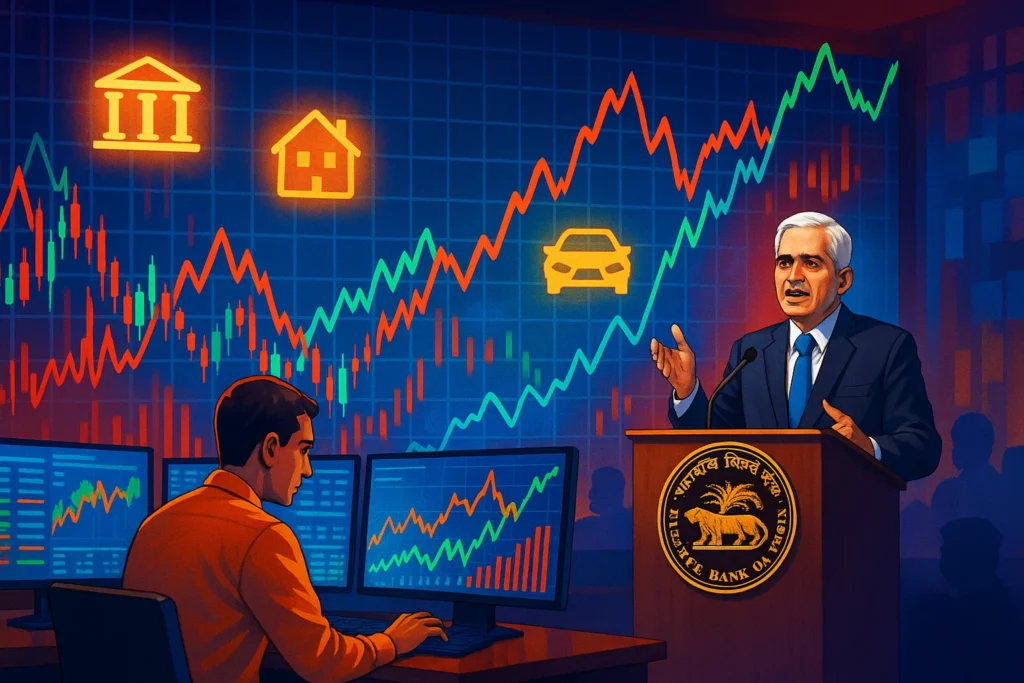Introduction
Every time the Reserve Bank of India (RBI) makes a policy announcement, the Indian stock market reacts — sometimes sharply, sometimes steadily — but always attentively. As the country’s monetary authority, the RBI controls key levers like interest rates, inflation targeting, and currency stability, all of which ripple through India’s diverse sectors in unique ways.
If you’re wondering how the RBI decision impact on stock market unfolds across industries, you’re in the right place. This blog breaks down the sector-wise effects of recent RBI moves, drawing on historical examples and the latest policy changes to help you understand where the opportunities and risks lie.
Understanding RBI’s Role: The Economic Thermostat
The RBI acts like a financial thermostat, adjusting the economy’s temperature through monetary policy. When it lowers repo rates—the rate at which banks borrow money—it cools borrowing costs, encouraging loans and investment. When it raises rates, borrowing becomes more expensive, slowing demand to control inflation.
But these decisions don’t affect all sectors equally. Let’s explore how different industries respond to RBI’s policy shifts, especially in light of recent developments in 2025.
Recent RBI Decisions and Their Market Impact
June 2025: Repo Rate Cut by 50 Basis Points to 5.50%
In a bid to stimulate economic growth amid moderating inflation, the RBI cut the repo rate by 50 basis points in June 2025, marking the third consecutive rate cut in less than a year.
Market Impact:
- Banking: Lower rates reduced loan EMIs, spurring credit demand. Banks like HDFC and ICICI reported stronger loan growth and improved margins.
- Automobiles: Vehicle financing became more affordable, driving sales increases for companies like Tata Motors and Hero MotoCorp.
- Real Estate: Home loan rates dropped, boosting residential property demand, especially in affordable housing segments.
April 2025: Repo Rate Cut by 25 Basis Points to 6.00%
Earlier in April, the RBI had reduced rates by 25 basis points as inflation eased and economic activity showed signs of recovery.
Market Impact:
- FMCG: Reduced interest rates and controlled inflation helped lower input costs for consumer staples companies like ITC and Britannia, improving profitability.
- Exports: Stable currency management by RBI supported exporters in IT and pharma, bolstering their competitiveness in global markets.
August 2025: RBI Holds Repo Rate Steady at 5.50%
Facing global economic uncertainties and trade tensions, the RBI opted for a neutral stance, keeping rates unchanged in August 2025.
Market Impact:
- Investor Sentiment: Cautious outlook led to slight market dips, with indices like Sensex and Nifty reacting to the pause in monetary easing.
- Sectoral Effects: Banking and real estate sectors showed muted growth expectations, reflecting market prudence.
Sector-Wise Impact of RBI Decisions
1. Banking & Financial Services: The Credit Growth Engine
Banks are the most sensitive to RBI rate changes. Historical data shows that every rate cut since 2019 has accelerated credit growth—from 9.8% in early 2019 to over 13% in early 2020. This boosts bank earnings through higher loan volumes and stable Net Interest Margins (NIMs).
When RBI pauses or hikes rates, loan demand cools, and margins tighten. So, tracking RBI decisions helps investors anticipate banking sector performance.
2. Infrastructure & Real Estate: Riding the Interest Rate Wave
Lower interest rates reduce borrowing costs for infrastructure projects and homebuyers. For example, L&T’s stock rose about 25% during the 2019–2020 easing cycle, while real estate developers like DLF saw improved sales as home loans became more affordable.
Conversely, RBI rate hikes in 2013–2014 led to slower project starts and a drop in real estate demand.
3. Automobiles & Consumer Durables: Financing Fuels Demand
Auto sales depend heavily on affordable financing. When RBI cut rates to historic lows in 2020, two-wheeler sales jumped 16% YoY in early 2021. Lower EMIs increase consumer willingness to buy vehicles and appliances, especially with rising rural incomes.
4. IT & Export-Oriented Sectors: Currency and Competitiveness
The rupee’s movement, influenced by RBI’s forex policy, greatly affects exporters. A weaker rupee in 2018 boosted dollar revenues for IT giants like Infosys, despite short-term volatility. RBI’s efforts to stabilize the currency in 2019 helped smooth earnings and support steady growth.
5. FMCG & Consumer Staples: Inflation and Cost Management
When inflation rises, FMCG companies face higher input costs, squeezing margins—as seen in 2017 when CPI breached 5%. RBI’s tightening helped control inflation, stabilizing costs and consumer spending. In periods of easing inflation, FMCG companies benefit from steady demand and pricing power.
6. Oil & Gas, Metals & Mining: Vulnerable to Commodities and Currency
These sectors are sensitive to global commodity prices and the rupee’s value. A weak rupee raises import costs for OMCs, squeezing margins, as happened in 2018 despite RBI’s tight policy. Metals companies rely on global cycles but benefit from RBI’s efforts to keep currency stable.
Short-Term vs Long-Term Market Reactions
RBI announcements often trigger immediate market moves—like the 3% Nifty jump after August 2019’s surprise 35 bps cut. But long-term effects depend on sustained policy and economic health.
Understanding this difference helps investors avoid knee-jerk reactions and focus on lasting trends.
Managing Risks: External Shocks and RBI Policies
While RBI guides the domestic economy, global events can override its influence. The 2014–15 commodity crash tested RBI’s ability to control inflation and the currency. Investors who diversified and hedged currency risks during such times fared better.
Final Thoughts: Align Your Investment Strategy with RBI Signals
The RBI decision impact on stock market is profound, nuanced, and sector-specific. Banks ride the waves of credit demand, infrastructure projects surge or stall with borrowing costs, exporters gain or lose with currency moves, and consumer sectors respond to inflation and rates.
To invest wisely, keep a close eye on RBI policy signals and understand their varied effects across sectors. Use these insights not just to react but to position your portfolio proactively for growth and risk management.
Next time the RBI announces its policy, you won’t just watch the market—you’ll understand the story behind the moves and know where to look for opportunities.
FAQs : RBI decision impact on stock market
What is the RBI decision impact on stock market?
RBI decisions influence interest rates, inflation, and currency, which affect different sectors and overall market trends.
How do RBI repo rate changes impact the stock market?
Repo rate changes affect borrowing costs, influencing sectors like banking, real estate, and automobiles.
Which sectors benefit most from RBI rate cuts?
Banking, infrastructure, automobiles, and real estate sectors usually gain from RBI rate reductions.
How does RBI policy affect export-oriented sectors?
RBI’s currency management impacts exporters by influencing the rupee’s value against foreign currencies.
What happens to FMCG stocks with RBI’s inflation control measures?
Effective inflation control by RBI helps FMCG companies manage input costs and maintain stable margins.
Can RBI decisions cause short-term market volatility?
Yes, RBI announcements often lead to immediate market reactions, especially in rate-sensitive sectors.
How should investors interpret RBI’s neutral stance on rates?
A neutral stance signals caution; investors may see subdued growth in sensitive sectors.
What is the long-term RBI decision impact on stock market sectors?
Long-term impacts depend on sustained policy direction affecting credit growth, inflation, and currency stability.
Does RBI impact affect commodity-linked sectors?
Indirectly, through currency and inflation policies, RBI decisions influence metals, mining, and oil sectors.
How can investors use RBI decision impact on stock market in portfolio strategy?
By understanding sector-wise effects, investors can adjust asset allocation to balance growth and risk.
More Articles
Underrated Stocks: How to Find Multibaggers from Your Daily Life
Best Screener Queries for Stock Selection: Find Hidden Gems Before Others Do
Predict Stock Reaction Before Earnings Using Market Signals






